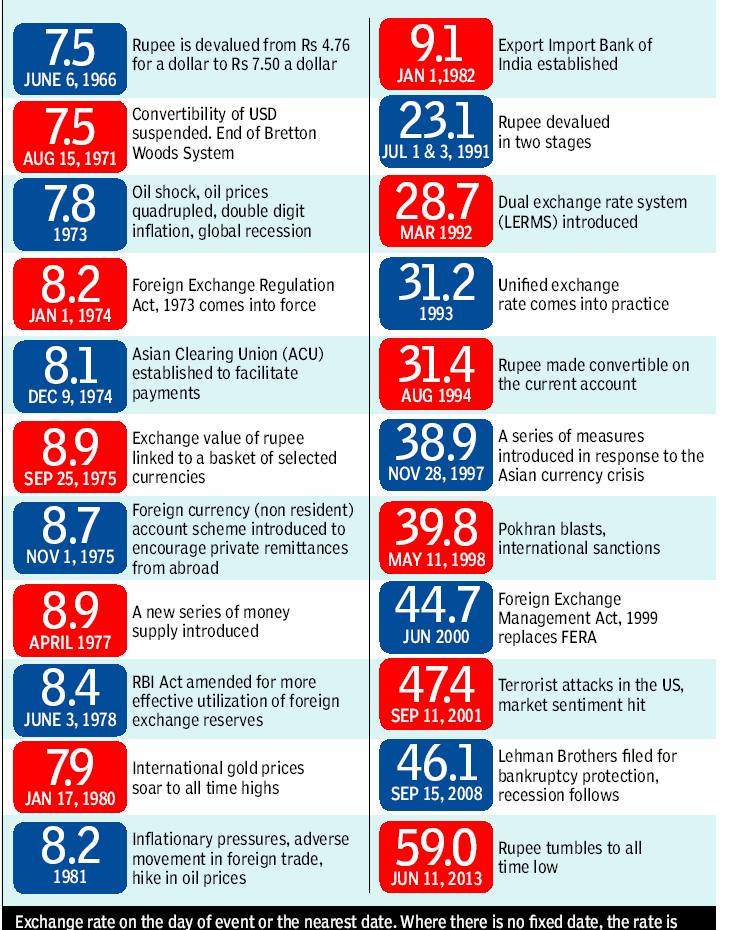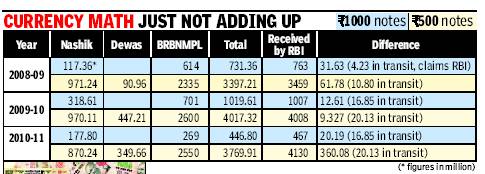Currency: India
This is a collection of newspaper articles selected for the excellence of their content. |
Contents |
The steady depreciation of the rupee
See the accompanying chart
The Times of India 15 June 2013
See Table 1 below
Unaccounted for rupees in circulation
Millions of notes not printed in mints land in RBI vaults
Bank, Press Records Don’t Tally
Hemali Chhapia TNN
The Times of India 2013/08/04
Mumbai: Millions of currency notes worth hundreds of crores of rupees that have apparently never been printed at our nation’s mints have mysteriously made it to the vaults of the Reserve Bank of India over the years.
A series of RTI applications reveal that while the mismatch between currency bills printed and those transported to the RBI is seen across denominations, it is more pronounced in the case of higher value notes — those of Rs 1,000 and Rs 500.
Take the Rs 1,000 notes. The redesigned bill was introduced in October 2000. Ever since, the two authorized mints — Bharatiya Reserve Bank Note Mudran Private Limited, Bangalore, and Currency Note Press, Nashik — have printed a total of 4,452.3 million bills. But RBI records show that it has received 4,462 million notes, an excess of 9.7 million notes. That means the RBI has received Rs 970 crore more than what was actually printed.
WHAT THE RBI SPOKESPERSON SAYS
You have collected the data of printing from the press and the supply received from RBI. You cannot do that because there are a lot of logistics involved. Numbers must be compared from the one source; either you take RBI numbers or the printing presses’ numbers. You cannot mix and match.
An aggregate discrepancy of Rs 4,608 crore
In 2006-07 the number of 1000-rupee notes received by the RBI was 589 million. (The number of such notes printed that year was 591m.)
While this closes the difference between what was printed and what was received to a considerable extent, there still remains a discrepancy of about Rs 72 crore for the period in question, which the bank has attributed to “rounding off”.
However, there is a large discrepancy between the numbers provided by the Bharatiya Reserve Bank Note Mudran, RBI’s wholly owned subsidiary, in its response to two similar queries just a month and a half apart under the Right to Information Act. A response dated November 10, 2011 to a query indicates the total count of Rs 500 notes printed between 2000-01 and 2009-10 as 10,878m while another response dated December 24, 2011 shows 10,806 m notes were printed—a difference of 72.782m notes valued at over Rs 3,639 crore (see Table 3).
Similarly, there is a difference in the case of currency notes of Rs 1000 denomination. The November response indicates the total number of Rs 1000 notes printed between 2000-01 and 2009-2010 as 3094.69m while the December response places it at 3,085m—a difference of 9.69m notes valued at Rs 969 crore (see Table 3).
The aggregate discrepancy—Rs 500 and Rs 1,000 notes—between the two RTI responses is a significant Rs 4,608 crore.

